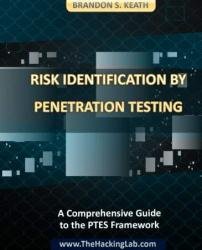Risk Identification by Penetration Testing: A Comprehensive Guide to the PTES Framework
- Добавил: literator
- Дата: 24-06-2023, 20:50
- Комментариев: 0
 Название: Risk Identification by Penetration Testing: A Comprehensive Guide to the PTES Framework
Название: Risk Identification by Penetration Testing: A Comprehensive Guide to the PTES FrameworkАвтор: Brandon S. Keath
Издательство: Leanpub
Год: 2023-05-04
Страниц: 121
Язык: английский
Формат: pdf (true)
Размер: 10.2 MB
Dive into the world of penetration testing with this comprehensive guide by cybersecurity expert, Brandon S. Keath. Explore each stage of the Penetration Testing Execution Standard, learn essential tools and techniques, and gain insights from real-world examples. Master the art of ethical hacking and become a skilled penetration tester.
"Risk Identification by Penetration Testing" is an indispensable resource for those looking to explore the captivating world of penetration testing and cybersecurity. Authored by Brandon S. Keath, the founder of TheHackingLab LLC, an industry expert with over 15 years of experience, and a corporate faculty member at Harrisburg University of Science and Technology, this comprehensive guide is specifically tailored to a 7-week introductory college course on penetration testing.
Brandon's extensive experience in ethical hacking, cybersecurity strategy, regulatory compliance, and cyber defense is brought to life in this groundbreaking book. As a speaker at numerous cybersecurity conferences, including BSIDES Harrisburg, BSIDES Long Island, and Harrisburg University Cyber Security Summit, he has consistently shared his expertise on penetration testing and ethical hacking with the community.
In this book, you will gain valuable insights from Brandon's wide-ranging experience as he covers essential topics such as risk assessment models, methodologies, and processes. Through hands-on examples and exercises, you will learn how to conduct mission-focused data risk assessments and provide strategic and tactical recommendations to senior leaders on mitigating risks to your organization's data.
In this section, we will explore post-exploitation with Metasploit, focusing on the main features of Meterpreter and the use of shells outside of Metasploit. Post-exploitation refers to the actions taken after gaining unauthorized access to a system. The goal is to maintain control, gather valuable information, and, in some cases, pivot to other systems within the network. Meterpreter is a powerful post-exploitation tool included in Metasploit. It provides advanced features and functionalities that facilitate information gathering, privilege escalation, maintaining access, and more. Meterpreter runs in memory, making it difficult to detect by antivirus software.
Key benefits of "Risk Identification by Penetration Testing" include:
A comprehensive introduction to penetration testing for students at all levels
Expert insights from a recognized authority in the field
Real-world examples and practical exercises to reinforce key concepts
The ideal companion for a 7-week college course on penetration testing
With a Master's degree in Cyber Security and Information Assurance, an MBA in IT management, and certifications such as EC-Council's Certified Ethical Hacker (CEH), Certified Hacking Forensics Investigator (CHFI), and CompTIA's PenTest+, Brandon is exceptionally qualified to guide you through this thrilling field. Don't miss the chance to learn from one of the best – secure your copy of "Risk Identification by Penetration Testing" today and embark on your journey into the world of penetration testing and cybersecurity!
The content of this book covers several key areas, walking through the Penetration Testing Process with the PTES framework:
Introduction to Penetration Testing and Risk Assessment: This chapter lays the foundation for understanding penetration testing and risk assessment by introducing key concepts, models, methodologies, and the PTES framework. It highlights the importance of mission-focused data risk assessments and sets the stage for the rest of the book.
Pre-Engagement Interactions and Intelligence Gathering: This chapter delves into the crucial pre-engagement interactions and intelligence gathering phase, discussing communication, rules of engagement, and reconnaissance techniques. It emphasizes the importance of documenting findings and prepares readers for the next phase of penetration testing.
Threat Modeling and Vulnerability Analysis: This chapter covers the process of identifying, modeling, and prioritizing threats and vulnerabilities. It provides an understanding of vulnerability scanning, analysis, and common vulnerability scoring systems to help readers effectively assess an organization's security posture.
Exploitation and Post-Exploitation: This chapter focuses on the exploitation phase, detailing various techniques and tools used to exploit vulnerabilities. It also discusses post-exploitation strategies, lateral movement, and maintaining persistence, which are crucial for understanding the potential impact of a successful cyber attack.
Reporting and Risk Mitigation: This chapter highlights the importance of documenting, reporting, and communicating findings to senior leaders and stakeholders. It guides readers on creating strategic and tactical recommendations for risk mitigation, remediation, and follow-up, emphasizing the need for clear communication.
Penetration Testing Tools and Techniques: This chapter provides an overview of popular penetration testing tools, including hands-on lab exercises with Metasploit, Nmap, PowerShell Empire, and CrackMapExec. It discusses customizing, scripting, and automating tools for specific testing scenarios, showcasing the versatility and adaptability required in the field of penetration testing. It also includes examples of custom exploits in Python and introduces automation strategies.
Simulating a Real Life Penetration Testing Environment: In this chapter, readers will learn how to create their simulated environments for practicing penetration testing. It covers setting up realistic environments and various options for automated configuration and testing, including cloud-based, home labs with VirtualBox, Kali Linux, and Docker. The chapter also encourages reflection on personal growth and development, preparing readers for future penetration testing engagements, and highlighting various careers for red teamers.
Скачать Risk Identification by Penetration Testing: A Comprehensive Guide to the PTES Framework
[related-news] [/related-news]
Внимание
Уважаемый посетитель, Вы зашли на сайт как незарегистрированный пользователь.
Мы рекомендуем Вам зарегистрироваться либо войти на сайт под своим именем.
Уважаемый посетитель, Вы зашли на сайт как незарегистрированный пользователь.
Мы рекомендуем Вам зарегистрироваться либо войти на сайт под своим именем.
